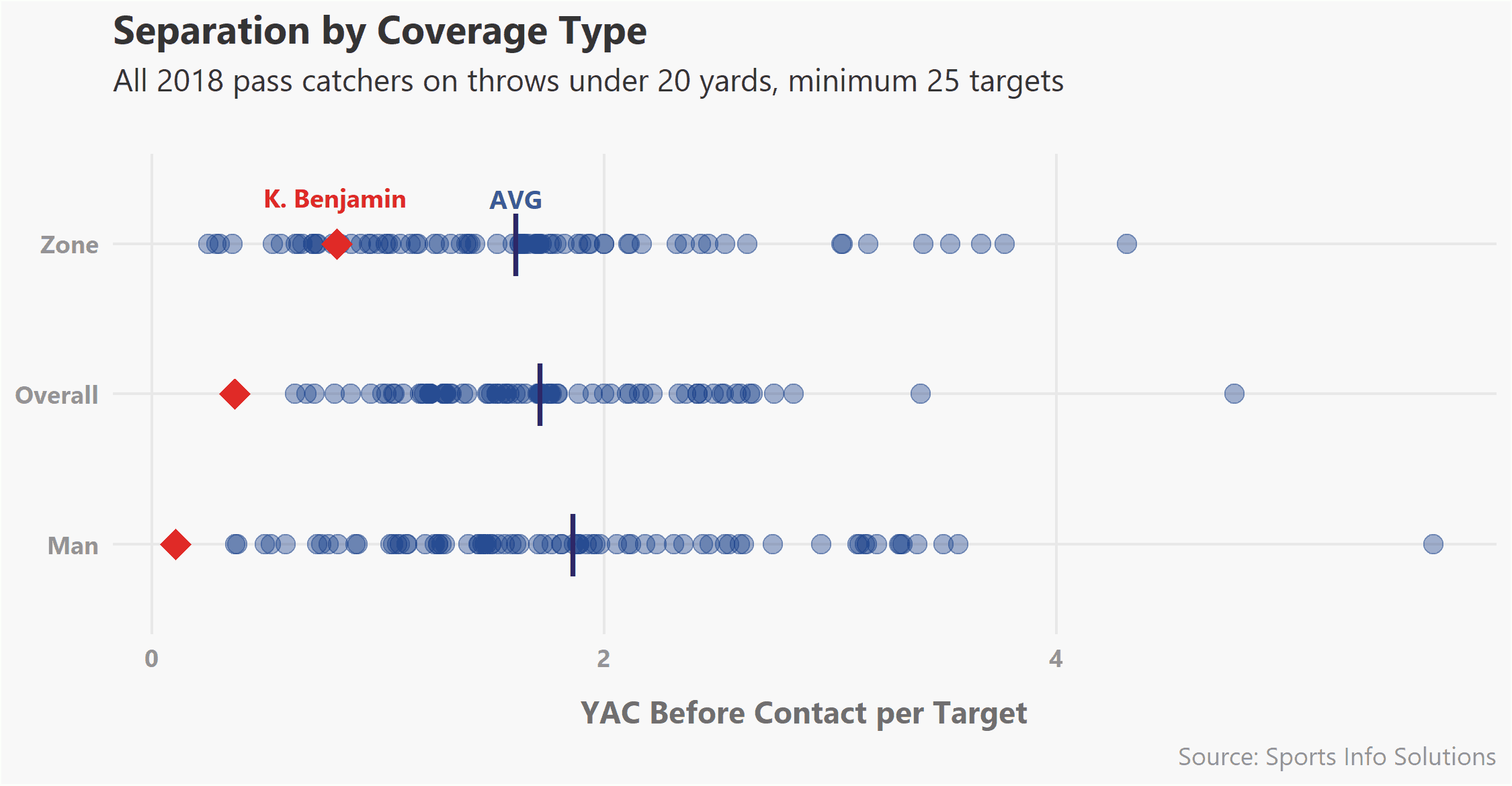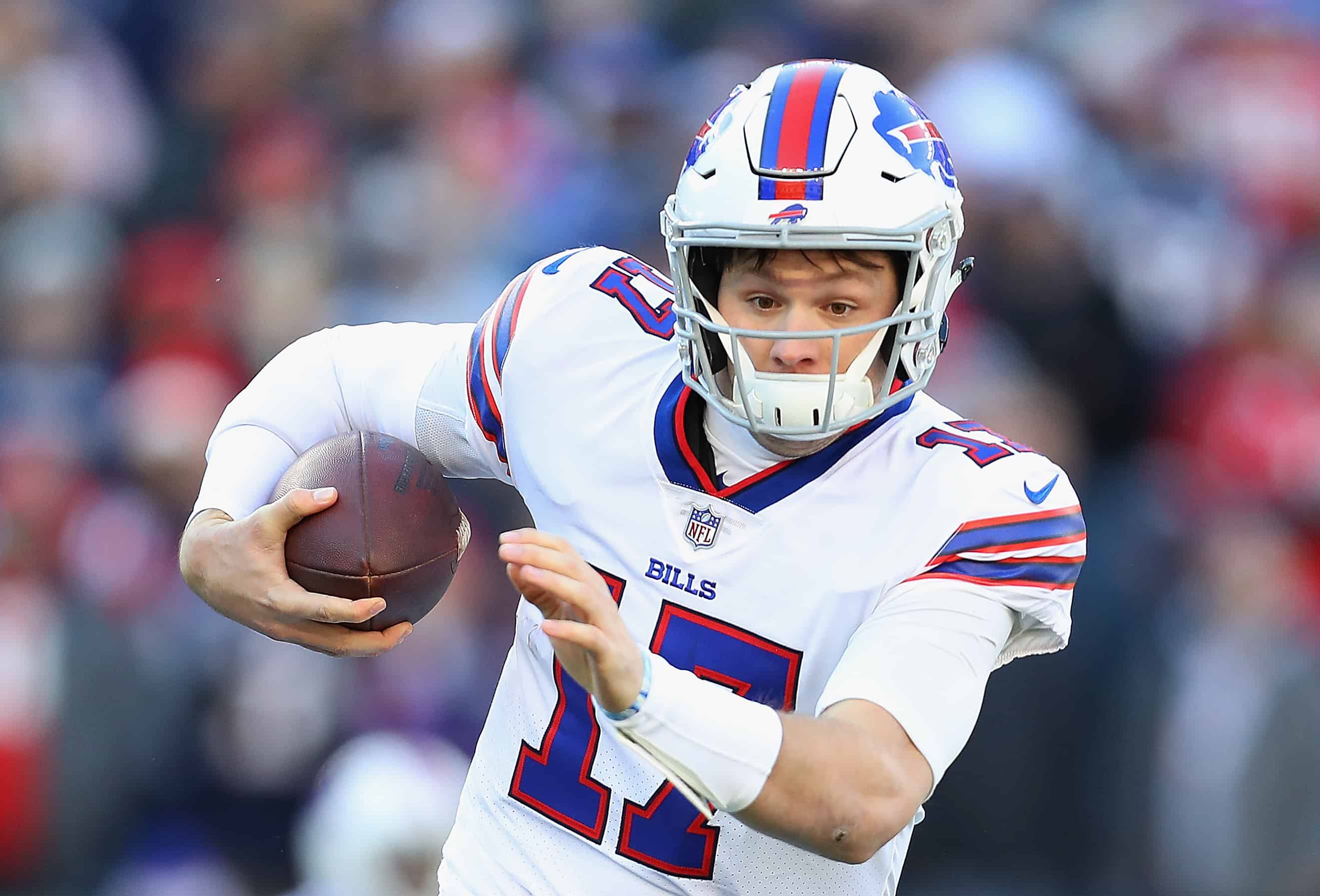Coming out of college, Josh Allen was as polarizing of a prospect as there’s been in the last decade, and his rookie season didn’t do much to change that. For each hurdle of a linebacker or long touchdown from a collapsing pocket, there was an equally head-scratching throw across his body or hilariously off-target five-yard pass.
To be fair to Allen, even his biggest supporters conceded all along he wasn’t pro-ready coming out of school, and for their part, the Buffalo Bills seemed to agree. Allen took a majority of training camp snaps with the 2s and 3s, and was never really given a fair shake at what was publicly an “open competition” for the starting spot. The merits of sitting a rookie quarterback behind a veteran can be debated, but the real problem was that “veteran” was Nathan Peterman, whose penchant for interceptions forced Allen onto the field in Week 2 after taking almost no snaps with the starters throughout camp.
Even still, the general response to Allen’s rookie season is that he was better than expected, which, original expectations aside, is a generally good thing. Allen showed flashes of what made him such an enticing prospect, but lacked the consistency that will be required if he wants to be a franchise quarterback moving forward.
So, let’s dive a bit more into Allen’s rookie season and take a look at what we might see from him moving forward.
The Obvious Stuff
This wouldn’t be a piece about Josh Allen without mention of his accuracy, so let’s get that out of the way. Based on just about every measure we have at Sports Info Solutions, Allen was among the least accurate quarterbacks in the NFL last season. His Catchable Throw Percentage (Catchable%) was second from the bottom, narrowly better than fellow rookie Josh Rosen. His completion percentage, oft-discussed in the analytics community, ranked dead last.
Allen’s accuracy issues were most prevalent in the intermediate and deep portions of the field. While his Catchable% on throws within 10 yards of the line of scrimmage was firmly in the middle of the pack, he ranked 31st of 33 quarterbacks on both intermediate throws (10-20 yards) and deep throws (>20 yards). This is particularly problematic in Allen’s case because of how often he pushed the ball downfield last year.
The other big story coming out of Allen’s rookie season was his ability on the ground. Whether it was because everyone was distracted by how tall he was or how far he could throw, Allen’s athleticism was seemingly undersold during the draft process. Allen led all quarterbacks in rushing yards, rushing yards per attempt, and Expected Points Added (EPA) running the ball in 2018. Most of this was Allen creating something from nothing. Overall, 508 of his 637 rushing yards and five of his eight rushing touchdowns came on scrambles. He also converted a first down on 60 percent of scrambles. Not surprisingly, these were all the best in the league.
The Bills’ offensive line will likely feature at least four new starters this season, so if all goes to plan Allen will be doing a little less running for his life, but it wouldn’t be shocking to see an increased number of RPO’s or designed QB runs to allow Allen to use his athleticism to his advantage.
Going Off Script
Because of how last season unfolded for the Bills, offensive coordinator Brian Daboll never really had a chance to tailor the playbook to Allen. With the quarterback room now exponentially more stable than it was at this time last year, Daboll finally has a chance to build an offense around Allen, and there is evidence that this is actually a big deal.
Like most young quarterbacks, Allen operates best from structure. He showed a huge drop off between scripted plays (the offense’s first 15) and the rest of the game. Allen’s drop in EPA per Attempt (EPA/A) between the two was the fifth largest in the league.
| COMP% | TD:INT | ADOT | EPA/A | IQR | |
|---|---|---|---|---|---|
| First 15 Plays | 56.20% | 3:00 | 8.3 | 0.12 | 90 |
| Rest of Game | 51.80% | 7:12 | 11.6 | -0.06 | 71.9 |
*IQR is Independent Quarterback Rating, which builds on the traditional Passer Rating formula by considering the value of a quarterback independent of results outside of his control such as dropped passes, dropped interceptions, throwaways, etc.
The lower Average Depth of Target (ADOT) also suggests he benefited from some easier throws where guys were schemed open. This is something Daboll should continue to emphasize. Allen threw a screen on only eight percent of his attempts in 2018, the fifth-lowest in the league. Using screens is a good way to combat Allen’s accuracy issues and propensity for playing hero ball.
Additionally, like most quarterbacks, Allen benefited greatly when the Bills used play-action. Allen’s IQR when using play-action was 86.9, compared to 68.5 without it, the seventh-largest swing in the league. Allen used play-action on about a quarter of his dropbacks last season, the 11th highest rate in the league, but it still wouldn’t be surprising to see that jump in the coming season.
Beating Man Coverage
Arguably the biggest area where Allen will need to show improvement is beating man coverage. In 2018, among 33 qualifying quarterbacks, Allen ranked 31st in Catchable% (62.7%), 32nd in Y/A (6.0) and 33rd in IQR (60.0) against man coverage. While the effects of Allen’s accuracy problems shouldn’t be understated, at least some of the blame for this can be deflected to the Bills’ receivers.
We can use Yards After Catch Before Contact (YACBC) to estimate how much separation a receiver was able to generate on a play. YACBC looks at how many yards a receiver was able to gain after the catch before a defender was able to get a hand on him. Looking at the metric on throws less than 20 yards downfield acts as a good proxy for how good a receiver is at separating from his defender.
Last season, Bills de facto number one receiver Kelvin Benjamin ranked dead last among 77 qualifying receivers in YACBC. Against man coverage specifically, Benjamin averaged 0.1 YACBC, which was also dead last. The Bills’ wide receivers as a whole ranked 26th in the league by this metric last season.

The good news for Bills fans is that Buffalo’s depth chart at receiver is barely recognizable compared to the unit that started last season. Former second-round pick Zay Jones is likely to be the only current Bills receiver who was also in the starting unit to begin last season, depending on if you count Robert Foster and Ray-Ray McCloud, who spent the early parts of last season bouncing around the practice squad and waivers.
The Bills’ offseason signings represent a continuation of some of their in-season moves from the tail end of last season and show a clear shift in mindset. Rather than trying to counter Allen’s accuracy issues with long guys who have a large catch radius, they are looking to widen the margin of error for Allen by getting guys who can generate separation. Down the stretch, Allen found more success targeting the likes of Robert Foster and Isaiah McKenzie, who, while undersized, were able to create separation.
Using the same constraints as above, Cole Beasley last season generated an average of 1.8 YACBC per target and 2.0 YACBC per target against man specifically, ranking 29th and 30th among qualifying receivers. Fellow free agent signee John Brown ranked 18th overall with 2.2 YACBC, and was the best in the league at generating separation against zone coverage with a YACBC of 4.3.
The Last Word
The narrative for Allen hasn’t changed much since last offseason. He flashed the upside of a long-term NFL quarterback, but rarely did it consistently. He relied pretty heavily on his athleticism to bail him out and struggled to throw the ball accurately, particularly down the field — all of which reads pretty closely to his scouting report out of college.
A quick glance at the Bills’ offensive depth chart from last season though will help to put things into perspective. The Bills thought they had a year before Allen was going to be playing, and the way their roster was built clearly reflects that. The Bills’ offensive line and top three receivers will be returning a total of two starters from last season, and the Bills’ backfield also has a handful of newcomers behind LeSean McCoy.
There are a lot of questions marks around Allen, but there are also reasons for optimism. Allen may not see the same jump that players like Jared Goff and Patrick Mahomes had in their second seasons, but the pieces are in place for Allen to be a lot better in year two.
Josh Allen 2018 Summary
| Category | Result |
|---|---|
| Attempts | 320 |
| Yards | 2074 |
| Comp% | 52.8% |
| Catchable% | 69.40% |
| TD:INT | 10:12 |
| Passer Points (Rank) | 24.7 (30) |
| Rusher Points (Rank) | 18.6 (4) |
Points Earned Per Attempt (38 Quarterbacks with 150+ Attempts)
| Situation | Attempts | Rank |
|---|---|---|
| vs Man | 150 | 34 |
| vs Zone | 135 | 27 |
| Short/Intermediate | 261 | 32 |
| Deep Plays | 59 | 33 |
| Pressured | 118 | 25 |
| Clean Pocket | 202 | 33 |
















